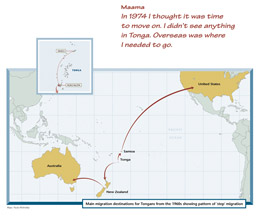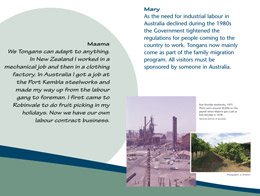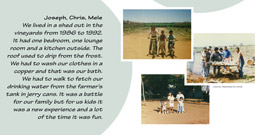| Robinvale perspectives |
Maamaloa-Fine family: First and second generation perspectives
![]()
From Tonga early 1970s to Robinvale 1986
The individual perspectives of two generations of the Maamaloa-Fine family enriched their migration story and created a sense of dialogue between them. The two members of the family most involved were Maama and his daughter Mele Kirirua.
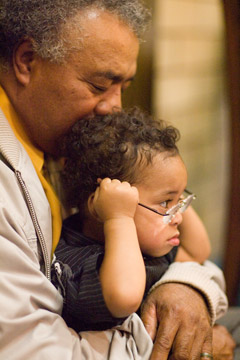 |
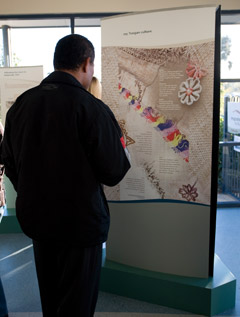
View of Maamaloa-Fine family’s story on display at Robinvale. Photograph: Jo Sheldrick, 2007. |
|
| Maama with his grandson. Photograph: Jo Sheldrick, 2007. |
Mapping the personal, the local and historical
The exhibition used maps, images and text to show the wider context in which Maama migrated first to New Zealand and then to Australia in the 1970s. Tongans began migrating for work on a large scale in the 1960s. When Australia began to accept more non-European migrants in the 1970s, many moved on from New Zealand.
| Details from Maamaloa-Fine family, panel one, Migration Memories: Robinvale. Design: Paula McKindlay. | ||
Maama found work at the Port Kembla Steelworks in Wollongong where his second and third children were born. In the 1980s he heard about horticultural work in Robinvale.
The local
As manufacturing industries closed down in the 1980s, rural work provided an important alternative for Tongans and other Pacific Islanders. In horticultural towns like Robinvale, they have become a significant section of the community.
| Detail from Maamaloa-Fine family, panel two, Migration Memories: Robinvale. Design: Paula McKindlay. |
The personal in historical context
The Maamaloa-Fine family started out as horticultural workers in Robinvale in much the same way as the first soldier settlers who arrived to take up their irrigation blocks.
Detail from Maamaloa-Fine family, panel one, Migration Memories: Robinvale. Design: Paula McKindlay. |
Looking back on the project
 |
|
| Mele. Photograph: Jo Sheldrick, 2007. |
Mele
Yeah, the process was really good. It’s really interesting because we – me and my brothers – even got talking about it as well, and they’d be asking me, ‘oh how’s that thing going with Mary?’ and I’m like, ‘oh yeah, my gosh thanks for reminding me’, and we’d start chatting about back in the days…we’d just bring up memories and talk about them. Which before we never even would have thought about…
Mary
Working with the Maamaloas was an evolving process. I first spoke to Maama and although he was interested in Tongans being involved in the project, he had very little time. Later I had a conversation with Mele and her brothers and we agreed that Mele would be the main person involved. As the process developed I also spoke with Leisi, Mele’s mother, and Maama himself became a more active participant.

